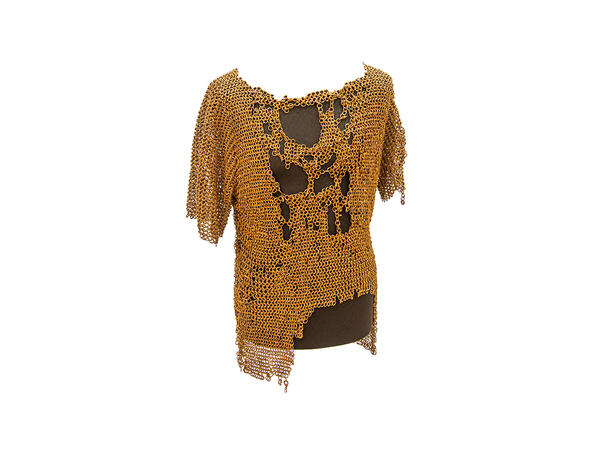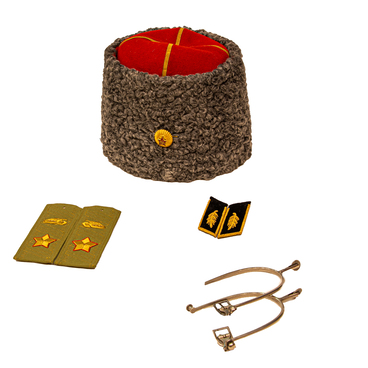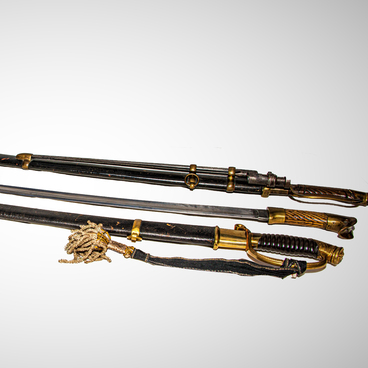The chain mail was the most widespread type of medieval armor. In Russia, its varieties were used until the 17th century.
One chain mail consisted of 20-25 thousand iron rings. It took about 600 meters of wire, about 1 millimeter thick. The production of such armor took about 200 man-hours.
The wire was first spiraled onto an iron rod and then cut along one side into separate rings. Their diameter ranged from six to ten millimeters — the smaller, the better the protective properties. Half of the rings were welded together, and the ends of the rest were put together and flattened with special pliers. After that a through hole was made in them and riveted with a pin — a small cylindrical rod. As a rule, one riveted ring in chain armor was connected to four welded ones.
Since the 12th century, the rings were flattened with a hammer, so they formed a denser protective coating. When the chain mail was finished, it was cleaned and given a mirror-like polish using sand.
The finished chain mail could weigh differently, from 6.5 to 10 kilos, but this weight was evenly distributed over the entire body surface. To prevent the armor from grazing the skin, thick clothing made of leather or felt was used, which was previously quilted in several layers or stuffed with cotton, tow, or bristles. This clothing also softened the impact force and prevented sharp weapons from getting deep into the flesh, if they did pierce the armor.
The chain mail protected from the saber cutting blows and protected well enough from the sword or ax blows. Experiments have shown, when struck hard by a sword, rings of soft wire simply bend around the blade.
However, the armor did not protect well from crushing weapons — a hammer or a mace. Even if they did not tear the chain armor fabric, they seriously damaged the internal organs. The chain armor also did not save from strong stabbing sword blows, and even more so from a direct blow with a spear. It also did not protect from bow and crossbow fire at a sight distance of 50-75 meters. Ordinary arrows pierced through the ring cells and inflicted shallow, but painful and bleeding wounds. Faceted-tipped arrows easily defeated the chain armor fabric and self-firing bolts.
Flat ring chain mails became popular in the 16th-17th centuries. They were lighter, cheaper, and easier to produce. The riders of the Prioksk defensive line at that time already preferred flat ring armor to all others: when Kolomna soldiers arrived at the Kolomna gathering in 1577, 156 of them were in flat ring mails. Three of them were in ‘tegilyai’ (the simplest and cheapest Tatar and Russian armor of the 16th century), and two were in chain mails, which remained in use until the end of the 17th century.
One chain mail consisted of 20-25 thousand iron rings. It took about 600 meters of wire, about 1 millimeter thick. The production of such armor took about 200 man-hours.
The wire was first spiraled onto an iron rod and then cut along one side into separate rings. Their diameter ranged from six to ten millimeters — the smaller, the better the protective properties. Half of the rings were welded together, and the ends of the rest were put together and flattened with special pliers. After that a through hole was made in them and riveted with a pin — a small cylindrical rod. As a rule, one riveted ring in chain armor was connected to four welded ones.
Since the 12th century, the rings were flattened with a hammer, so they formed a denser protective coating. When the chain mail was finished, it was cleaned and given a mirror-like polish using sand.
The finished chain mail could weigh differently, from 6.5 to 10 kilos, but this weight was evenly distributed over the entire body surface. To prevent the armor from grazing the skin, thick clothing made of leather or felt was used, which was previously quilted in several layers or stuffed with cotton, tow, or bristles. This clothing also softened the impact force and prevented sharp weapons from getting deep into the flesh, if they did pierce the armor.
The chain mail protected from the saber cutting blows and protected well enough from the sword or ax blows. Experiments have shown, when struck hard by a sword, rings of soft wire simply bend around the blade.
However, the armor did not protect well from crushing weapons — a hammer or a mace. Even if they did not tear the chain armor fabric, they seriously damaged the internal organs. The chain armor also did not save from strong stabbing sword blows, and even more so from a direct blow with a spear. It also did not protect from bow and crossbow fire at a sight distance of 50-75 meters. Ordinary arrows pierced through the ring cells and inflicted shallow, but painful and bleeding wounds. Faceted-tipped arrows easily defeated the chain armor fabric and self-firing bolts.
Flat ring chain mails became popular in the 16th-17th centuries. They were lighter, cheaper, and easier to produce. The riders of the Prioksk defensive line at that time already preferred flat ring armor to all others: when Kolomna soldiers arrived at the Kolomna gathering in 1577, 156 of them were in flat ring mails. Three of them were in ‘tegilyai’ (the simplest and cheapest Tatar and Russian armor of the 16th century), and two were in chain mails, which remained in use until the end of the 17th century.



